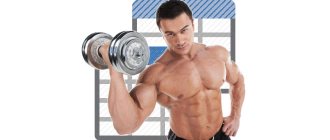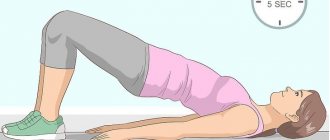How to recover faster after a hard workout in the gym - take medications, go for special procedures, or just give the body a rest? In this article we will describe the most common methods of muscle recovery. But first, let's talk about how the body reacts to training and how to behave after heavy loads.
What is body restoration?
The human body is a complex system that monitors and regulates its own condition. At rest and during light loads, all processes proceed at a normal pace. But the load forces you to use reserve energy reserves to ensure normal functioning of the body during heavy exercise.
During exercise, the production of cortisol increases, which destroys muscles, and it is because of this that soreness appears. Thus, training takes up a huge amount of reserves, which now have to be restored. That is, it is necessary to return the original anatomical, physiological and biochemical state that was originally.
The body itself hints what needs to be done to recover. You may notice that after training you want to eat more and sleep longer. Indeed, nutrition and rest are important components of a harmonious and complete recovery.
After physical activity, the body also prepares for more serious loads, which is expressed in an increase in muscle mass. And the stronger the previous load, the more thorough this preparation. This is why training at the edge of your capabilities is the most effective. Endurance increases not during sports, but during the rest period. This is why it is so important to be able to recover properly after training.
Fast and slow recovery muscle groups
The entire human muscular system consists of different types of muscles, which have different sizes and rates of return to normal.
Fast
These are all the muscles of the arms: flexors and extensors of the fingers and hands, as well as biceps and triceps, which are popular for pumping. This also includes the gluteus medius and minimus muscles and the cervical group. It takes 2-3 days for them to recover. After this period, you can start split training again.
Average
These include deltoids, teres muscles, obliques and hamstrings. Depending on the difference in development, they are adjacent to the gastrocnemius. Rest for such groups is given as early as 3-4 days; in less time you may not get a better result.
Long
These are the largest muscles of the body - the pectoral muscles, abs, quadriceps and broad thigh muscles, as well as the trapezius. Their recovery period can be 5–6 days, that is, splits for these groups are best carried out once a week.
Recovery stages
The body recovers gradually, in four phases:
- Fast recovery. Lasts approximately 30 minutes after the end of the workout. At this time, severe hunger usually occurs, as the body strives to replenish its supply of nutrients as quickly as possible.
- Slow recovery. At this stage, the regeneration of tissues and cells begins, the water-electrolyte balance returns to normal and the substances that came with food are actively absorbed. They will become the building material for new muscle tissue. Enzyme, protein and amino acid synthesis are also launched.
- Supercompensation phase. It occurs approximately on the third day after heavy exercise and ends on the fifth day. During this period, an increase in physical indicators is observed, that is, the body is preparing for new loads. The next session must be carried out before the supercompensation phase ends.
- Delayed recovery. Occurs after supercompensation if the athlete stops visiting a fitness club or gym. During the process of delayed recovery, the body returns to the same shape it was in before starting training, which is why it is so important not to skip training.
Why is regeneration so important?
Any physical activity , especially heavy exercise, is stressful for the body . When you exercise, you strain different muscles, which means you will damage muscle cells . Muscle recovery takes some time as it takes 24 to 48 hours . Therefore, frequent training without breaks, on the contrary, does not stimulate muscle growth. [2]
Therefore, you should never train the same muscle parts for two days in a row when it comes to strength training. Find out how to create a training plan in our article How to create a high-quality training plan - tips, training, the most common mistakes.
The intense pace of the exercise takes its toll. The polysaccharide glycogen, which is found in the liver and muscles, is excreted from the body. It is responsible for controlling blood sugar levels and providing the muscles with the necessary energy . For rapid recovery after long-term training, replenishment of glycogen stores to initiate repair and adaptation of muscle tissue. To maximize muscle glycogen levels, you need to consume carbohydrates. [3]
However, consuming carbohydrates is not the only guaranteed way to recover muscles after a hard workout. That's why we've prepared 8 tips for you on how to recover your muscles after a workout.
How to behave during the recovery period
Here are the basic tips to follow so as not to interfere with the body's natural recovery:
- Avoid stress. Psychological comfort contributes to full physical recovery. If troubles do happen, then relaxation and meditation help to cope with them.
- Follow the regime. Get up and go to bed at the same time. Eating should also be regular - you shouldn’t skip meals during the day and then gorge yourself before bed.
- Sleep at least 8 hours a day, preferably 9-10. Sleep should be comfortable and uninterrupted.
- Avoid scheduling workouts in the early morning and late evening—just before or after bedtime. The body needs to wake up and prepare for stress, this needs at least an hour.
- Get plenty of rest during the day. Allow yourself to completely relax for at least 15 minutes and forget about the work process and problems. The lower the voltage, the better.
You may be interested in these products:
Remember to hydrate
Water plays an important role in regeneration. It promotes the proper functioning of processes in the body that ensure muscle recovery after exercise. Remember that muscles are almost 75% water . [14] There are several reasons to stay hydrated after a hard workout. Hydration actually:
- Supports muscle recovery . Exercise and a balanced diet support muscle growth through muscle protein synthesis. However, protein synthesis requires that muscles be well hydrated . If you and your muscles are dehydrated after a workout , protein synthesis slows down, which delays recovery. [4]
- Improves digestion – as mentioned above, muscles need to restore glycogen levels after exercise. Therefore, it is important to eat foods rich in carbohydrates . Digestion, however, requires water. Saliva, which helps break down food, is composed primarily of liquids and is essential for digestion and nutrient absorption . Therefore, adequate hydration will facilitate digestion and therefore regeneration. [5]
- Reduces fatigue . One of the most common symptoms of dehydration is fatigue . Failure to comply with the drinking regime leads to a decrease in blood volume. This means the heart has to work harder to pump blood to all parts of the body that need vital oxygen and nutrients. Fatigue not only hinders post-workout recovery, but feeling sluggish also reduces motivation and desire to continue exercising.
Remember to eat a balanced diet
Are you hungry immediately after training? You should not neglect this because your body needs nutrients. Eating after a workout is essential to ensure your muscles work properly.
Nutrients important for muscle regeneration include the aforementioned carbohydrates as well as proteins. [6] The body breaks down proteins into amino acids , which serve as the building blocks of muscle fibers. Without protein, tense muscles cannot recover , or the body may consume amino acids from other sources, which should not be allowed. [7]
Vitamins and minerals are also important substances. On the one hand, they help to obtain the benefits of proteins more efficiently , on the other hand, they release hormones necessary for regeneration.
Quality sleep
During sleep, the body releases growth hormones , which help muscles grow and promote fat burning . At night, some body functions are not active, so the body has enough time to repair damaged tissues . The better you sleep, the better your muscles recover .
This is why sleep time also plays an important role in the regeneration process. If you're one of those people who thinks they only need 5 hours of sleep , know that your body suffers from it. He does not have enough time to recover, which increases the risk of injury. Getting enough sleep and rest is one of the best ways to speed up muscle regeneration. [15] Therefore, try to sleep at least 7-8 hours a day.
Book a massage
Massage improves blood circulation and at the same time relaxes the tense body. Muscle massage has a positive effect, which professional athletes especially should not forget about. Stimulating muscle mass can prevent pain that typically occurs 2-6 hours after an intense workout.
Research shows that using a foam roller removes and seals scar tissue. This is important because it is often the main cause of muscle and joint pain after exercise . Try a few minutes of massage in the morning and evening and after a while you will feel the difference. Massage will reduce the risk of injury and promote muscle recovery [9]
Ice and cold baths can help soothe muscle pain
Whether you're working out hard at the gym, training for a marathon, or just want to do something for your health, it won't be without pain . Your muscles are torn, so there is a slight inflammation that causes pain . Ice relieves pain in the affected area by reducing the speed of the nervous reaction. This will slow down the pain signals between the muscles and the brain, so you will feel almost no pain .
One of the easiest ways to recover from a tough workout is this. Apply an ice pack to sore muscles for 20 minutes to help them recover faster . Cold baths or cryotherapy are also popular, used by professional athletes to recover and reduce muscle pain after intense training and competition. [10]
Many popular runners, professional football players and famous bodybuilders do not use ice pools after training. Some athletes, in addition to the ice pool, use a contrast shower, alternating cold and warm water. [eleven]
Don't forget to stretch
Regular muscle stretching has many benefits. Stretching can help increase your flexibility , which is an important factor in fitness and improves your posture . In addition, regular and long-term muscle stretching reduces stress and eliminates pain.
Stretching is a great way to relieve muscle tension and prevent post-workout pain. Stretching or yoga exercises are some of the best activities you can do to help repair muscles and prevent future injuries. Stretching can be especially beneficial for you on non-workout days. Over time, you will feel a positive effect in the form of a decrease in soreness. [12]
Active regeneration
Active rest is low-intensity immediately after finishing a hard workout. The paradox is that the best way to recover from a marathon or other sporting activity is simply through active rest.
Active regeneration may include jogging or cycling. It differs from typical regeneration in that it lasts longer than a few minutes . Therefore, it can be considered a continuation of the training plan.
The main goal of active recreation is to keep your heart rate above your resting rate. Therefore, at the end of your workout it is useful to include exercises such as:
- lifting light weights (30% less load than usual)
- yoga and its less vigorous forms such as hatha, yin or slow vinyasa
- bicycle or stationary bicycle
- elliptical or rowing machine
- swimming
- hiking, brisk walking or jogging
How to understand that muscles have recovered
There are three main signs:
- A surge of strength, a general increase in energy.
- Noticeable reduction or complete absence of muscle pain.
- High motivation for further sports and other activities during the day.
To clearly understand that the recovery process is going correctly, a combination of the listed signs is necessary with constant progress - an increase in muscle mass and the ability to withstand increasingly greater loads. In order for the body to fully recover, it is necessary to accurately assess the level of permissible loads during each workout and especially at the very beginning of sports.
Club "Mango" offers, which will help determine what condition the muscles are in and what exactly needs to be done so as not to be overloaded during the training process and get the maximum effect.
Recovery methods after spine surgery
So, as we said earlier, rehabilitation begins immediately, even after surgery to remove a hernia of the lumbar spine, or after using any other technology. We emphasize that manipulations using metal structures in the cervical region and other areas of the spine are the most traumatic and require longer immobilization of the patient and longer recovery periods.
Hyperextension - strengthening the lumbar region.
Another point is that many procedures are performed due to pinched nerve endings; after decompression, they still need to recover, so neurological symptoms may persist for a short period. It should be understood that the nerve tissues were subjected to pressure for a long time during the illness and now, after eliminating the damaging factor, the inflamed roots that were released will take some time to return to normal. In addition, pain in the initial stages is a natural physiological reaction of the body associated with intraoperative trauma to soft tissues.
Next, we suggest that you familiarize yourself with the existing methods of rehabilitation benefits offered to a patient who has undergone surgery on the spine. They will facilitate and significantly speed up the recovery process.











